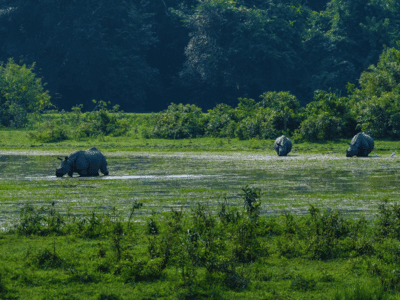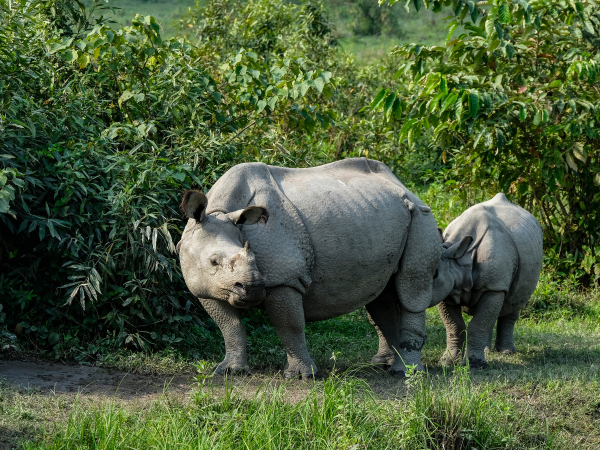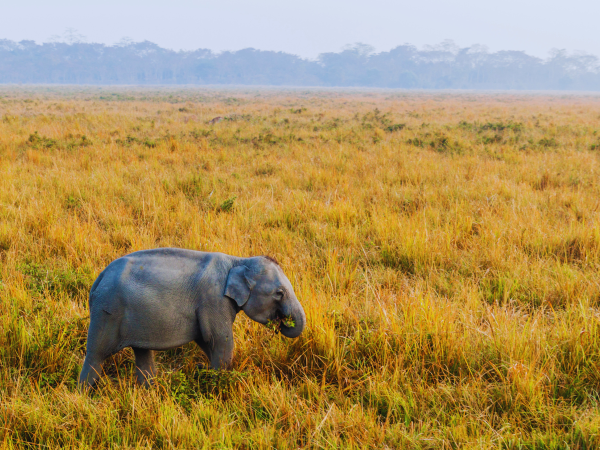
Welcome to Kaziranga. Nestled in Assam along the Brahmaputra River, Kaziranga National Park is a UNESCO World Heritage Site and is one of India’s most celebrated wildlife destinations. The reason is quite obvious. It’s that premier destination that did manage to bring back the once-dwindling rhino numbers, thanks to decades of conservation efforts, strict protection measures, and community involvement that turned the park into a global success story for wildlife revival. The result is there for everybody to see. Reportedly, the rhino numbers have bounced back impressively, though challenges like habitat loss and poaching persist. Spanning over 1,000 sq km, the park has a landscape of natural mosaic of grasslands, swamps, and forests. Here are some more compelling reasons to plan a trip to Kaziranga now.
The iconic one-horned rhino

As stated earlier, Kaziranga is globally renowned as the stronghold of the endangered one-horned rhinoceros. It’s now home to nearly two-thirds of the world’s population, and can be often spotted grazing in meadows or cooling off in marshy pools, the reason why visitors won’t have to depend much on their luck to spot one.
A rich biodiversity hotspotKaziranga is a place not just to spot the one-horned rhinos, as it also shelters elephants, wild water buffalo, swamp deer, and leopards. It needs to be noted that it’s one of the few reserves in the country where tigers and rhinos coexist, making it one of India’s richest biodiversity zones.
Read More:
Asia’s 8 greatest safari adventures involving unique wildlife
Paradise for birdwatchersKaziranga is also a haven for birders. As an important bird area, attracting thousands of migratory birds every year, spotting pelicans, storks, cranes, and even fish eagles shouldn’t be much of a problem. These birds crowd its wetlands, turning the park into a paradise for ornithologists and photographers alike.
Jeep safari thrillsJeep safaris are the most popular way to explore Kaziranga. Early morning drives take people through mist-covered grasslands, where sudden rhino sightings are a norm, and herds of deer darting across trails. Also, there are guides to bring alive stories of the wild with every turn.
Elephant safari experienceFor a more immersive encounter, elephant safaris are also available that offer a thrilling perspective. Riding high above the grass, visitors often get remarkably close to rhinos and other wildlife while enjoying the gentle sway of the forest giants.

The Brahmaputra’s InfluenceThe mighty Brahmaputra River nourishes Kaziranga’s ecosystem. Its seasonal floods replenish soil fertility, sustain wetlands, and shape the park’s unique terrain, though they also test the resilience of both wildlife and conservation teams each year.
Best time to visitKaziranga remains open from November to April. Winter months offer crisp weather, while spring bursts with migratory birds. The monsoon is avoided due to heavy flooding, which submerges large parts of the park.
Read More:
Durga Puja 2025: 10 best places in India to join the festivities
Conservation success storyAnti-poaching patrols, community participation, and eco-tourism initiatives have made Kaziranga a conservation model. Once-dwindling rhino numbers have bounced back impressively, though challenges like habitat loss and poaching persist.
Beyond wildlifeKaziranga offers more than safaris. Visitors can savour Assamese cuisine, tour tea gardens, or enjoy cultural performances in nearby villages. A journey here is as much about people and heritage as it is about the wild.
 Welcome to Kaziranga. Nestled in Assam along the Brahmaputra River, Kaziranga National Park is a UNESCO World Heritage Site and is one of India’s most celebrated wildlife destinations. The reason is quite obvious. It’s that premier destination that did manage to bring back the once-dwindling rhino numbers, thanks to decades of conservation efforts, strict protection measures, and community involvement that turned the park into a global success story for wildlife revival. The result is there for everybody to see. Reportedly, the rhino numbers have bounced back impressively, though challenges like habitat loss and poaching persist. Spanning over 1,000 sq km, the park has a landscape of natural mosaic of grasslands, swamps, and forests. Here are some more compelling reasons to plan a trip to Kaziranga now.
Welcome to Kaziranga. Nestled in Assam along the Brahmaputra River, Kaziranga National Park is a UNESCO World Heritage Site and is one of India’s most celebrated wildlife destinations. The reason is quite obvious. It’s that premier destination that did manage to bring back the once-dwindling rhino numbers, thanks to decades of conservation efforts, strict protection measures, and community involvement that turned the park into a global success story for wildlife revival. The result is there for everybody to see. Reportedly, the rhino numbers have bounced back impressively, though challenges like habitat loss and poaching persist. Spanning over 1,000 sq km, the park has a landscape of natural mosaic of grasslands, swamps, and forests. Here are some more compelling reasons to plan a trip to Kaziranga now.

